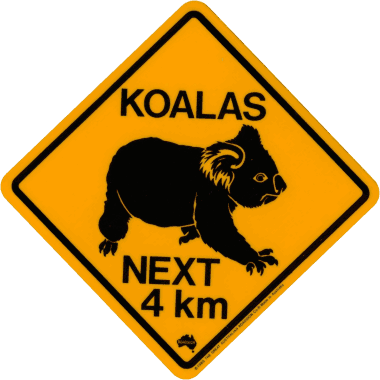
09 Feb 2021
Koala Trees at Wollongong Botanic Garden
Koala Trees at Wollongong Botanic Garden
By Michael Connor, Wollongong Botanic Garden
Why did the Koala cross the Road? To get to the habitat on the other side.
Most Australians haven’t seen a Koala in the wild, so it shouldn’t come as a surprise that Koalas are a threatened species in NSW and Southern Queensland. In recent times politicians have even been at logger heads over the fate of this iconic species. To help people get involved in the debate and appreciate the plight of this important native animal, Wollongong Botanic Garden is producing a self-guided walk on the Food and Habitat trees preferred by Koalas in our region.
Here is an example of what’s in store…

Signs for the a self-guided walk on the Food and Habitat trees preferred by Koalas in our region
Koalas live in a range of open forest and woodland communities but ultimately their habitat is defined by the presence of a select group of food trees. They are reasonably fussy eaters, grazing mostly on a few Eucalypts. In the Illawarra and south coast of NSW the Cabbage Gum Eucalyptus amplifolia and the Forest Red Gum Eucalyptus tereticornis are key food trees for the Koala, but other Eucalypts such as the stringy barks and boxes will do at a pinch. They may even resort to other species such as the Bloodwoods Corymbia, Paperbark Melaleuca, Turpentine Syncarpia, She Oak Allocasurina, and even some species of Banksia. Koalas will certainly use these trees as habitat, often preferring trees with thicker canopies to shelter from the sun and elements. They sometimes take up temporary residence in exotic trees such Camphor Laurels during extreme temperatures if their key food trees are nearby.
It’s difficult to spot these tree dwellers in their natural habitat, the fur on a Koala’s bottom has a speckled appearance which makes them difficult to see in the canopy. The easiest way to discover a koala resting in a tree is by looking down to see their droppings on the ground. These are small green-brown, fibrous pellets about 20 mm long and as thick as a pencil. The fresher the pellets, and the more abundant, the more likely Koalas are somewhere overhead.
Travellers in Australia often only spot Koalas as road- kill (busy roads and Koalas don’t mix). If you want to see these cute Australians you should leave the car at home, then walk, ride a bike, or go by train to known areas of Koala habit. If you chose to take the journey by car, drive more slowly and carefully, because Koalas really do cross the road to get to their ever-shrinking habitat on the other side.

If you want to learn more about the trees that are important for Koala survival, simply cross the road to Wollongong Botanic Garden and follow the Koala signs on the trail.

